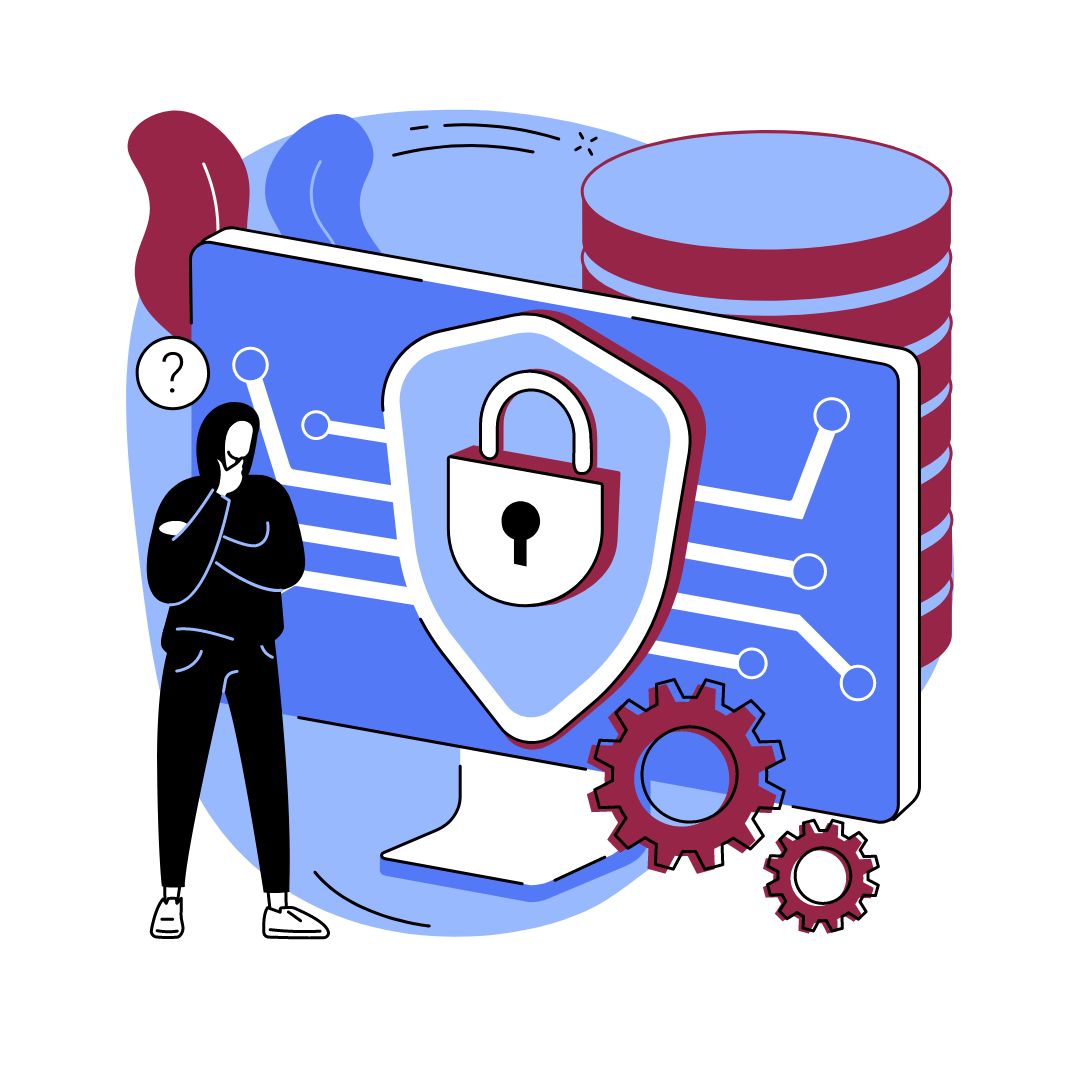Top 50+ Cyber Security Interview Questions and Answers 2024
Last updated 22nd.April.2024
50+ Cyber Security interview Questions and Answers, both for freshers & Experienced of up to 3 years

Contents

Interview Questions
Questions No: 1 to 10

Interview Questions
Questions No: 11 to 20

Interview Questions
Questions No: 21 to 30

Interview Questions
Questions No: 31 to 40

Interview Questions
Questions No: 41 to 50

Interview Questions
Questions No: 51 to 56
Q. What is the role of a Security Operations Center (SOC) analyst, and how does it contribute to an organization's cybersecurity posture?
Answer: SOC analysts are responsible for monitoring, detecting, analyzing, and responding to cybersecurity incidents. They play a crucial role in maintaining the security infrastructure and promptly addressing threats to protect sensitive information and systems.

Q. What are the primary responsibilities of an ethical hacker, and how do they differ from those of a malicious hacker?
Answer: Ethical hackers, also known as white-hat hackers, use their skills to identify vulnerabilities in systems, networks, and applications. They help organizations strengthen their security by finding and fixing weaknesses before malicious hackers exploit them.
Q. Can you explain the concept of penetration testing and its significance in cybersecurity?
Answer: Penetration testing involves simulating cyberattacks to assess the security of an organization’s systems, networks, and applications. It helps identify vulnerabilities and weaknesses that could be exploited by attackers, enabling organizations to proactively address them.
Q.What are some common cybersecurity threats that organizations face today, and how can they mitigate these threats effectively?
Answer: Common cyber security threats include malware, phishing attacks, ransomware, and insider threats. Organizations can mitigate these threats by implementing robust security measures such as antivirus software, email filtering, regular security awareness training, and access controls.
Q. Explain the difference between symmetric and asymmetric encryption, and provide examples of their respective use cases.
Answer: Symmetric encryption uses the same key for both encryption and decryption, while asymmetric encryption uses a pair of public and private keys. Symmetric encryption is faster and more suitable for encrypting large amounts of data, while asymmetric encryption is often used for secure communication and digital signatures.
Q. What is a firewall, and how does it help protect networks from unauthorized access?
Answer: A firewall is a network security device that monitors and controls incoming and outgoing traffic based on predetermined security rules. It acts as a barrier between a trusted internal network and untrusted external networks, preventing unauthorized access and potential cyberattacks.
Q. Describe the concept of multi-factor authentication (MFA) and its importance in enhancing security measures.
Answer: Multi-factor authentication requires users to provide multiple forms of verification before gaining access to a system or application. This typically includes something the user knows (such as a password), something they have (such as a smartphone or token), and something they are (such as a fingerprint). MFA adds an extra layer of security beyond just passwords, making it more difficult for unauthorized users to gain access.
Q. What are some best practices for securing web applications against common vulnerabilities such as SQL injection and cross-site scripting (XSS)?
Answer: Best practices for securing web applications include input validation, using parameterized queries to prevent SQL injection, implementing security headers to mitigate XSS attacks, and regularly updating and patching software to address known vulnerabilities.
Q. What is the difference between vulnerability scanning and penetration testing, and when should each be used?
Answer: Vulnerability scanning involves scanning systems and networks for known vulnerabilities, while penetration testing involves simulating cyberattacks to identify and exploit weaknesses. Vulnerability scanning is typically automated and used for regular security assessments, while penetration testing is more comprehensive and used to assess the effectiveness of security controls.
Q. How does encryption help protect data at rest and data in transit, and what are some encryption algorithms commonly used for this purpose?
Answer: Encryption converts plaintext data into ciphertext to prevent unauthorized access. It helps protect data at rest by encrypting stored data and data in transit by encrypting communication between systems. Common encryption algorithms include AES (Advanced Encryption Standard), RSA, and ECC (Elliptic Curve Cryptography).
Want to learn
Cyber Security Course? If Yes Click
or want to continue reading Cyber Security Interview Questions
Q. What are the key components of a comprehensive incident response plan, and why is it essential for organizations to have one in place?
Answer: A comprehensive incident response plan includes preparation, detection, containment, eradication, recovery, and lessons learned. It helps organizations effectively respond to security incidents, minimize damage, and recover quickly from cyberattacks.
Q. Explain the concept of least privilege and its importance in access control.
Answer: Least privilege principle states that users should only be granted the minimum level of access necessary to perform their job functions. It helps reduce the risk of unauthorized access and limit the potential impact of security breaches by restricting privileges to only what is essential.
Q. Describe the concept of threat intelligence and how it can help organizations improve their cybersecurity defenses.
Answer: Threat intelligence involves collecting and analyzing information about potential cybersecurity threats, including tactics, techniques, and procedures (TTPs) used by threat actors. It helps organizations anticipate and prepare for emerging threats, enhance their incident response capabilities, and make informed decisions to mitigate risks.
Q. What are the main differences between black-box and white-box testing, and when is each used in the context of cybersecurity?
Answer: Black-box testing involves testing a system or application without knowledge of its internal workings, while white-box testing involves testing with full knowledge of the system’s internals. Black-box testing simulates how an attacker would approach a target, while white-box testing provides deeper insight into vulnerabilities and weaknesses.
Q. How can organizations ensure compliance with relevant cybersecurity regulations and standards, such as GDPR, HIPAA, or PCI DSS?
Answer: Organizations can ensure compliance with cybersecurity regulations and standards by implementing appropriate security controls, conducting regular risk assessments, and establishing policies and procedures to address specific requirements. They should also invest in employee training and awareness programs to ensure adherence to regulatory requirements.
Q. What are some common social engineering techniques used by attackers to manipulate individuals and gain unauthorized access to systems and information?
Answer: Common social engineering techniques include phishing, pretexting, baiting, and tailgating. Attackers use psychological manipulation to deceive individuals into disclosing sensitive information, such as passwords or login credentials, or performing actions that compromise security.
Q. In the context of cybersecurity, what role does threat hunting play in proactive threat detection and mitigation, and what are some key strategies and techniques used by threat hunters to identify potential security threats before they manifest into incidents?
Answer: Threat hunting involves proactively searching for signs of malicious activity within an organization’s network and systems that may have evaded traditional security measures. Threat hunters leverage various strategies and techniques, such as analyzing log data for anomalies, conducting behavioral analysis to identify suspicious patterns, and using threat intelligence to anticipate and investigate potential threats.
By continuously monitoring and analyzing network traffic and system behavior, threat hunters can identify and mitigate security threats before they escalate into significant incidents, enhancing the organization’s overall cybersecurity posture.
Q. How do you stay updated with the latest trends and developments in cybersecurity, and what resources do you rely on for continuous learning and professional growth?
Answer: Staying updated with the latest trends and developments in cyber security requires continuous learning and active participation in the cybersecurity community. I rely on a variety of resources such as cybersecurity blogs, online forums, professional networking events, and training courses offered by organizations like the Cyber Security Academy. Additionally, I actively participate in conferences and webinars to gain insights into emerging threats and best practices in the industry.
Q. Explain the concept of zero-day vulnerability. How do you handle it?
Answer: A zero-day vulnerability is a security flaw that is unknown to the software vendor. Handling it involves immediate mitigation measures, such as applying temporary fixes or workarounds until a permanent solution is available.
Q. What is the principle of the CIA triad in information security?
Answer: The CIA triad stands for Confidentiality, Integrity, and Availability, which are three key objectives of information security
Q. Describe how a Distributed Denial of Service (DDoS) attack works.
Answer: A DDoS attack overwhelms a system, network, or service with a flood of traffic from multiple sources, causing it to become unavailable to legitimate users.
Q. What is a Distributed Denial of Service (DDoS) attack, and how can organizations mitigate its impact on their systems and networks?
Answer: A DDoS attack floods a target system or network with a massive amount of traffic, causing it to become unavailable to legitimate users. Organizations can mitigate the impact of DDoS attacks by implementing DDoS mitigation solutions, such as traffic filtering, rate limiting, and using content delivery networks (CDNs) to absorb excess traffic.
Q. Explain the concept of privilege escalation in cyber security.
Answer: Privilege escalation is the process of gaining higher levels of access or permissions than originally intended by exploiting vulnerabilities in a system.
Q. What is the difference between vulnerability assessment and penetration testing?
Answer: Vulnerability assessment identifies and quantifies vulnerabilities in a system, while penetration testing simulates real-world attacks to exploit vulnerabilities and assess the security posture of a system.
Q. How does a firewall work, and what are the different types of firewalls?
Answer: A firewall filters network traffic based on predefined rules to allow or block data packets. Types include packet-filtering, stateful inspection, proxy, and next-generation firewalls.
Q. What is the purpose of intrusion detection systems (IDS) and intrusion prevention systems (IPS)?
Answer: IDS detects and alerts on potential security threats, while IPS actively blocks or prevents unauthorized access or malicious activities.
Q. Describe the role of cryptography in cyber security.
Answer: Cryptography ensures data confidentiality, integrity, and authenticity through encryption, decryption, and digital signatures.

Q. What is a man-in-the-middle (MitM) attack, and how can it be prevented?
Answer: A MitM attack intercepts communication between two parties to eavesdrop or modify data. Prevention methods include encryption, certificate validation, and using secure communication protocols.
Q. Explain the concept of secure coding practices.
Answer: Secure coding practices involve writing code with security considerations to prevent vulnerabilities such as injection attacks, buffer overflows, and cross-site scripting (XSS).
Q. What is the purpose of a security information and event management (SIEM) system?
Answer: SIEM systems play a crucial role in cybersecurity by collecting, analyzing, and correlating security event data from various sources such as network devices, servers, and applications. They provide real-time monitoring, threat detection, incident response, and compliance reporting capabilities. Additionally, SIEM helps organizations detect and respond to security incidents more effectively by centralizing and correlating logs and alerts from disparate sources.
Q. Describe the difference between black-box and white-box testing in application security.
Answer: Black-box testing, also known as external testing, assesses an application from an outsider’s perspective without any knowledge of its internal workings, design, or code. Testers focus on evaluating the application’s functionality, interfaces, and behavior based on specified inputs and expected outputs. In contrast, white-box testing, also known as internal testing or structural testing, examines an application’s internal structure, design, and code to uncover vulnerabilities, logic flaws, and security weaknesses. Testers have access to the application’s architecture, source code, and documentation, allowing them to perform in-depth analysis and identify potential security issues from within.
Q. How does a virtual private network (VPN) enhance security for remote access?
Answer: A virtual private network (VPN) enhances security for remote access by creating a secure, encrypted connection between a user’s device and the corporate network over an untrusted network, such as the internet. VPNs use tunneling protocols and encryption techniques to ensure the confidentiality and integrity of data transmitted between the user and the corporate network. By encrypting data at the source and decrypting it at the destination, VPNs prevent unauthorized interception, eavesdropping, or tampering of sensitive information by malicious actors. Additionally, VPNs provide authentication mechanisms to verify the identity of users and ensure secure access to corporate resources from remote locations.
Q. Explain the concept of least privilege in access control
Answer: Least privilege is a security principle that states that users, processes, or systems should only be granted the minimum level of access or permissions necessary to perform their authorized tasks or functions. By limiting access rights to only what is required for legitimate purposes, least privilege minimizes the potential impact of security breaches, insider threats, or misuse of privileges. This principle helps reduce the attack surface, mitigate the risk of unauthorized access, privilege escalation, and data breaches, and enforce the principle of separation of duties. Implementing least privilege requires defining and enforcing access controls, roles, permissions, and segregation of duties based on the principle of least privilege.
Q. What is the difference between active and passive reconnaissance in cyber security?
Answer: Active reconnaissance involves actively probing, scanning, or interacting with target systems, networks, or applications to gather information, identify vulnerabilities, or enumerate resources. Examples of active reconnaissance techniques include port scanning, network mapping, banner grabbing, and service fingerprinting.
Active reconnaissance can be more intrusive and may trigger security alerts or detection mechanisms, potentially alerting defenders to the presence of an attacker. In contrast, passive reconnaissance is more stealthy and involves observing, monitoring, or collecting information passively without directly interacting with target systems. Passive reconnaissance techniques include traffic analysis, open-source intelligence (OSINT) gathering, social engineering, and dumpster diving. Passive reconnaissance is less likely to raise suspicion or trigger security alarms, making it harder to detect and defend against.
Q. How does data masking contribute to data security and privacy?
Answer: Data masking, also known as data obfuscation or anonymization, is a technique used to conceal or protect sensitive information by replacing real data with fictional, anonymized, or scrambled values while preserving the data’s format, structure, and usability. Data masking helps mitigate the risk of data breaches, unauthorized access, or misuse of sensitive information by limiting exposure to only authorized users or applications.
By masking sensitive data such as personally identifiable information (PII), financial records, or intellectual property, organizations can comply with privacy regulations, protect customer confidentiality, and prevent identity theft, fraud, or unauthorized disclosure. Data masking techniques include encryption, tokenization, redaction, substitution, shuffling, and masking algorithms tailored to specific data types and privacy requirements.
Q. What are the key components of a disaster recovery plan, and why is it important for cyber security?
Answer: A disaster recovery plan (DRP) is a structured approach to recovering and restoring business operations, IT systems, and data assets in the event of a disruptive incident, disaster, or cyber attack. Key components of a DRP include risk assessment, business impact analysis, recovery objectives, backup and recovery procedures, communication strategies, testing and maintenance, and documentation. DRP is essential for cybersecurity because it helps organizations prepare, respond, and recover from cyber attacks, data breaches, ransomware, natural disasters, or other unexpected events that could disrupt business operations or compromise critical infrastructure.
By implementing a comprehensive DRP, organizations can minimize downtime, data loss, financial losses, reputational damage, and regulatory penalties associated with cyber incidents. DRP ensures business continuity, resilience, and operational readiness by establishing clear roles, responsibilities, and procedures for incident response, recovery, and continuity of operations.
Q. Explain the concept of threat intelligence and its relevance in cyber security operations.
Answer: Threat intelligence is information that helps organizations understand and mitigate cyber threats by providing actionable insights into attacker tactics, techniques, and procedures (TTPs), emerging vulnerabilities, and malicious activities targeting their assets, networks, or systems. Threat intelligence sources include open-source intelligence (OSINT), commercial feeds, industry reports, threat actors’ forums, government agencies, and internal security data. Threat intelligence is relevant in cybersecurity operations because it enables organizations to proactively identify, prioritize, and respond to security threats in real-time.
By leveraging threat intelligence, organizations can enhance their situational awareness, threat detection capabilities, incident response effectiveness, and risk management strategies. Threat intelligence supports various cybersecurity functions such as threat hunting, vulnerability management, intrusion detection, threat modeling, and security operations center (SOC) operations, helping organizations stay ahead of evolving cyber threats and protect their assets, data, and reputation.
Q. Explain the concept of a security token and its role in authentication.
Answer: A security token is a physical or digital device that generates one-time passwords or cryptographic keys used for authentication purposes. Tokens enhance security by adding an additional layer of authentication beyond traditional passwords, making it harder for attackers to compromise user accounts through credential theft or phishing attacks. Common types of security tokens include hardware tokens, software tokens (e.g., mobile authenticator apps), and smart cards.
Q. What is the difference between a vulnerability and an exploit?
Answer: A vulnerability is a weakness or flaw in a system, application, or network that could be exploited by attackers to compromise its security. An exploit is a piece of software or code that takes advantage of a vulnerability to carry out malicious actions such as gaining unauthorized access, executing arbitrary commands, or causing system crashes. In other words, a vulnerability represents a potential security risk, while an exploit is the means by which that risk is realized.
Q. Describe the role of a security operations center (SOC) in cybersecurity.
Answer: A security operations center (SOC) is a centralized facility that houses a team of cybersecurity professionals responsible for monitoring, detecting, analyzing, and responding to security incidents and threats in real-time. SOC analysts utilize advanced security tools, technologies, and processes to identify suspicious activities, investigate security alerts, and coordinate incident response efforts. The SOC plays a critical role in enhancing an organization’s cybersecurity posture by providing continuous threat monitoring, incident detection, and rapid response capabilities.
Q. What is a software-defined perimeter (SDP), and how does it enhance network security?
Answer: A software-defined perimeter (SDP) is a security framework that dynamically creates secure, isolated network connections between authorized users and resources based on identity and context. SDP solutions utilize encryption, micro-segmentation, and access controls to create a “zero-trust” network architecture, where access to resources is restricted to only authenticated and authorized users or devices. By eliminating the concept of a network perimeter and implementing granular access controls, SDP enhances network security by reducing the attack surface, preventing lateral movement, and thwarting unauthorized access attempts.
Q. Explain the concept of containerization in the context of application security.
Answer : Containerization is a lightweight virtualization technology that encapsulates applications and their dependencies into isolated, portable containers. Containers provide a standardized environment for running applications across different computing environments, such as development, testing, and production environments.
From a security perspective, containerization enhances application security by isolating and sandboxing individual applications, reducing the risk of dependency conflicts, and minimizing the impact of security breaches or vulnerabilities.
Containerization platforms such as Docker and Kubernetes also offer built-in security features such as image signing, resource isolation, and runtime monitoring to further enhance security.
Q. What is the principle of defense in depth, and how does it apply to cybersecurity?
Answer: Defense in depth is a cybersecurity strategy that employs multiple layers of security controls, safeguards, and countermeasures to protect against a wide range of threats and attacks.
The principle of defense in depth recognizes that no single security measure is foolproof and that an attacker may bypass or overcome individual security controls.
By implementing overlapping layers of defense, including network segmentation, access controls, encryption, intrusion detection, and user awareness training, organizations can mitigate the risk of successful cyber attacks and minimize the impact of security breaches.
Q. Describe the concept of a honeypot in cybersecurity, and how is it used to detect and analyze threats?
Answer: A honeypot is a decoy system or network designed to attract, deceive, and monitor attackers, allowing security researchers or organizations to gather intelligence about their tactics, techniques, and motivations. Honeypots simulate vulnerable or valuable assets, such as servers, databases, or IoT devices, to lure attackers into engaging with them. By monitoring the activities of attackers within the honeypot environment, cybersecurity professionals can gather valuable threat intelligence, identify emerging threats, and analyze attack patterns without exposing production systems to risk.
Q. What is the difference between symmetric and asymmetric encryption?
Answer: Symmetric encryption uses the same key for both encryption and decryption, making it faster and more efficient for bulk data encryption. Asymmetric encryption, also known as public-key cryptography, uses a pair of keys (public and private) for encryption and decryption, providing stronger security and enabling secure key exchange and digital signatures. While symmetric encryption is suitable for securing data transmission and storage, asymmetric encryption is often used for key management, authentication, and secure communication between parties.
Q. Explain the concept of threat modeling in cybersecurity, and why is it important?
Answer: Threat modeling is a systematic approach to identifying, assessing, and mitigating potential security threats and vulnerabilities in software, systems, or applications. It involves analyzing the architecture, design, and functionality of a system to identify potential attack vectors, entry points, and security weaknesses.
Threat modeling helps organizations prioritize security controls, allocate resources effectively, and make informed decisions about risk management and mitigation strategies. By proactively identifying and addressing security risks during the design and development stages, threat modeling reduces the likelihood of security breaches, data leaks, and compliance violations.
Q. What are the key components of a security incident response plan, and how does it help organizations mitigate cyber threats?
Answer: A security incident response plan outlines the procedures, roles, and responsibilities for detecting, responding to, and recovering from security incidents such as data breaches, cyber attacks, or system compromises. Key components of a security incident response plan include incident detection and classification, alerting and escalation procedures, containment and eradication measures, forensic analysis, communication strategies, and post-incident review and lessons learned.
By establishing a structured and coordinated approach to incident response, organizations can minimize the impact of security breaches, reduce downtime, preserve evidence for investigation, and restore normal operations in a timely manner.
Q. What is the concept of threat hunting, and how does it complement traditional security measures?
Answer: Threat hunting is a proactive cybersecurity approach that involves actively searching for signs of malicious activity or indicators of compromise within an organization’s network, systems, or endpoints. Unlike traditional security measures that rely on automated detection tools and predefined rules, threat hunting leverages human expertise, intuition, and investigative techniques to identify stealthy or advanced threats that may evade detection by automated defenses. Threat hunting complements traditional security measures by providing a proactive and adaptive defense capability that can uncover hidden threats, zero-day vulnerabilities, or insider attacks that may go unnoticed by automated security controls.
Q. Describe the concept of network segmentation, and how does it enhance network security?
Answer: Network segmentation is the practice of dividing a computer network into smaller, isolated segments or subnetworks to improve security, performance, and manageability. By logically or physically separating different parts of the network, organizations can control and restrict access to sensitive resources, contain the spread of malware or cyber attacks, and enforce security policies more effectively.
Network segmentation enhances network security by reducing the attack surface, limiting the scope of potential breaches, and preventing lateral movement by attackers within the network. Segmentation can be implemented using techniques such as VLANs, subnets, firewalls, and access controls.
Q. What is a security information and event management (SIEM) system, and how does it contribute to cybersecurity?
Answer: A security information and event management (SIEM) system is a centralized platform that aggregates, correlates, and analyzes security event data from various sources across an organization’s IT infrastructure. SIEM systems collect logs and telemetry data from network devices, servers, applications, and security tools to provide real-time monitoring, threat detection, incident response, and compliance reporting capabilities.
By correlating and analyzing security events in context, SIEM helps organizations detect suspicious activities, identify security incidents, and respond to cyber threats more effectively. SIEM also supports forensic analysis, incident investigation, and regulatory compliance by providing centralized visibility and audit trails of security-related events.
Q. What is the concept of encryption key management, and why is it important for cybersecurity?
Answer: Encryption key management involves generating, distributing, storing, and protecting cryptographic keys used for encryption, decryption, and authentication purposes. Proper key management practices are essential for maintaining the confidentiality, integrity, and availability of encrypted data and ensuring secure communication and data protection.
Key management encompasses key generation, key storage, key exchange, key rotation, key revocation, and key destruction processes. Effective key management helps organizations mitigate the risk of unauthorized access, data breaches, and cryptographic attacks such as key theft, brute-force attacks, or key compromise. It also ensures compliance with regulatory requirements and industry standards for data protection and privacy
